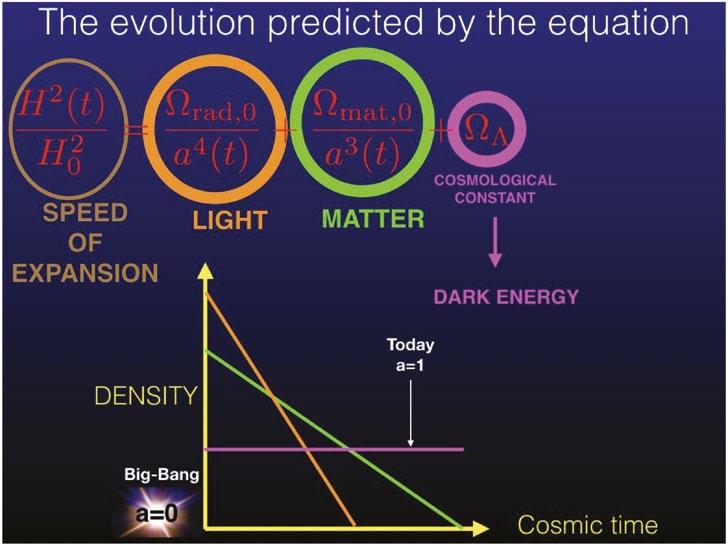
8 minute read
The Equation of the Universe in the life of an overthinker Giorgio Manzoni
The Equation of the Universe in the life of an overthinker
Giorgio Manzoni
Advertisement
Figure 1: Example of a spiral galaxy. Andromeda is our twin galaxy and we can see it fully (we cannot see the Milky Way in the same way just because we are inside it).
Since the beginning of humankind, people have been wondering about the Universe. Acknowledging the fact that we will probably never know the reason why there is a Universe and why it is like this, scientists started to apply their hard math to model it. The equation of the Universe is one of the biggest achievements in that direction but it might sound a bit intimidating. Is it actually possible to describe the entire Universe with just an equation? What does it mean to describe the Universe? Moreover, is the community of scientists reliable?
I am Giorgio, I’m a PhD in astrophysics, but my primary school teacher used to call me “Valentino”. It’s an Italian name but if you split it into two parts it becomes “va-lentino”, which means, with a little bit of imagination, “someone who goes slowly”. With probably all of the best intentions, she thought that humiliating me in front of my classmates would have stimulated me to be faster and at the pace of the other “average-speed” kids. I have never changed. I found myself many times wondering about things that everybody around me would have accepted as they were, without wasting additional time. Curiosity can be demanding in terms of time and not everybody would consider it well spent. After high school, this sense of curiosity pushed me to enrol into the Physics degree. I was uncertain as I have always been fascinated by Philosophy or Psychology and that would have been an easier choice given my natural skills. Having finished my bachelor, I completed a Master’s in Astrophysics and here I am now in Durham for my PhD.
After a while in this field, I can tell you, my dear overthinker friend, that, even if not immediately appreciated, overthinking about the Universe is always worth it. The reason is the following. Sometimes we like to take things for granted because it helps us to make faster decisions and free up space in our brain. However, this is a very dangerous process when you are dealing with a Universe consisting of material where 70% is as yet unidentified. Scientists decided to call it Dark Energy, exactly because the origin is completely obscure. However I can tell you that overthinking about it, is not just a good idea but it’s something necessary if we want to progress in science.
When studying cosmology I became suddenly fascinated about how we can describe the Universe in a simple threeingredients cooking recipe. Wait, you are not surprised enough: I am saying that if you have these three things, you can create the Universe you live in! These ingredients are: matter (Ωmat,0about 30%), light (Ωrad,0about 0.008%) and dark energy (Ωʌabout 70%). Unfortunately, not particularly easy to find at the local market… To complicate things a bit, that 30% of matter is not completely under control as only 4% of it is composed by matter we know, called by astrophysicists baryonic matter, and the remaining 26% is named dark matter. Yes, do not let the confusion come into your mind, you read it right. Dark matter is not dark energy, and, in our Universe, there is no real reason for treating dark matter differently from baryonic matter.
You might have guessed at this point that when things become “dark”, it means that they are not completely understood. True. However, while dark energy is probably one of the biggest enigmas in astrophysics, we can “see” dark matter quite well through the eyes of gravity. Take the example of a spiral galaxy (Figure 1), like our wonderful Milky Way, the galaxy we live in. With our telescopes, we can see very well that the stars in this kind of galaxy rotate around the centre of the galaxy. Furthermore, we can measure the rotational velocity of these stars! For example, on average, stars in the Milky Way rotate at 220 kilometres per second (pretty fast, isn’t it? How many kilometres can you run in one second?). Assuming we have understood gravity pretty well, it is impossible to reproduce the rotation of galaxies without taking into consideration the contribution of additional matter, which unfortunately cannot be seen with any telescope. Although the concept of invisible matter might not sound very scientific, it actually is because the reason
we are used to seeing the matter with our eyes is that it interacts with light. However, the fact that it happens on Earth does not mean it has to happen in the entire Universe.
For dark energy, the argument is a bit more complex. We live in a universe that is in expansion. This means that if we look at any other galaxy with our telescopes, we actually see this galaxy moving apart from us. Note that this does not mean we are in the centre of the Universe, as the same effect would happen in whatever galaxy we would find ourselves sitting in. Since gravity alone would attract objects together, we need an additional component to bring them apart. That’s why we need dark energy. Of course, this is not the only reason for dark energy. For example, without dark energy, we would not be able to describe the curvature of the Universe but let’s leave this for another time.
At this point, you might wonder where the equation of the Universe is. Ok ok, I don’t want to disappoint you. Here it is:
This is the first Friedman equation1, and you might have noticed that I have already mentioned the Ω terms. They are the densities of the ingredients of the Universe as measured today (0.008% for the light2 , 30% for the matter, and 70% for the dark energy3).

On the left-hand side, what we are trying to describe is the velocity of the expansion of the Universe.
On the right-hand side, the “a” term is the scale factor, a measure of the expansion of the Universe with a=0 at the moment of the big-bang and a=1 today.
If you feel confused, don’t worry: the concept hidden behind the equation is very simple. And I am going to explain it here for you.
Basically this equation is able to describe the past epochs of the Universe.
If you focus on the right-hand side of the equation (you can compare the terms of the equation in Figure 2), you can see that the density terms for the light and the matter appear always together with the scale factor. Consider the Universe as a box with light and matter inside (the size of this box is the scale factor “a”). As the box becomes bigger and bigger, the density of light Ωrad and matter Ωmat will become smaller and smaller (that’s because the total amount of light and matter is not changing). Instead, the big surprise is that the density of dark energy Ωʌ is independent of the size of the box. The more the Universe expands, the more dark energy is created in order to keep the density constant (wow!). This inevitably brings us to the fact that during the evolution of the Universe, different epochs followed one another: the first one after the Big-Bang is the era dominated by the light, and then a matterdominated Universe followed and just “recently” (about when the Earth formed) we entered the Dark Energy dominated era with an exponentially accelerated expansion.
Now, mio caro amico lettore4, if you have reached this point, you might wonder how an overthinker reacts to this equation. I know that in your heart you want to ask me: “are you absolutely certain that the Universe behaves like that?”.
I guess this question applies to every branch of science. Even more in cosmology, as all we can do is observe the sky and there is no way we can touch the Big-Bang or reproduce it in a laboratory. What I can tell you is that this is the most accurate and widely accepted model of the Universe at the moment5. However, every day, astronomers from all over the world are testing it in various ways in order to find if it holds true. Up until now, there are no models that can fully substitute this one without introducing any “collateral effect”6 (i.e. predicting something that is not observed in the sky). Yet, that does not mean that in the future this model will not be corrected or a new general model, that includes the current one as a small part of the bigger picture, will not be discovered. In fact, this has already happened when Einstein found a theory which automatically incorporated Newton’s gravity as a special case. Hence, the message I want to leave to you is: never stop questioning yourself, this world and the entire Universe!
1.
2.
3.
4.
5.
6. I apologise with any reader who is interested in the curvature of the Universe. I took the right to neglect that term for the sake of simplicity, and because all of today’s measurements show that this curvature is zero. However, if this bothers you, you can find the full Friedman equation in any cosmology book or even on Wikipedia. Astronomers refer to light as “radiation” which is why the “rad” in the subscript. The Dark Energy is described in the equation by the cosmological constant ʌ. Even Einstein included it in his equation for general relativity but he was conflicted and later he even stated that it was the biggest mistake of his life.
My dear friend reader.
It’s called the ʌCDM (Lambda Cold Dark Matter) Universe. There are a lot of attempts to model the Universe trying to get rid of the dark components. Search for example “modified gravity theories”.
Figure 2. The evolution of the ingredients of the Universe described by the equation.











